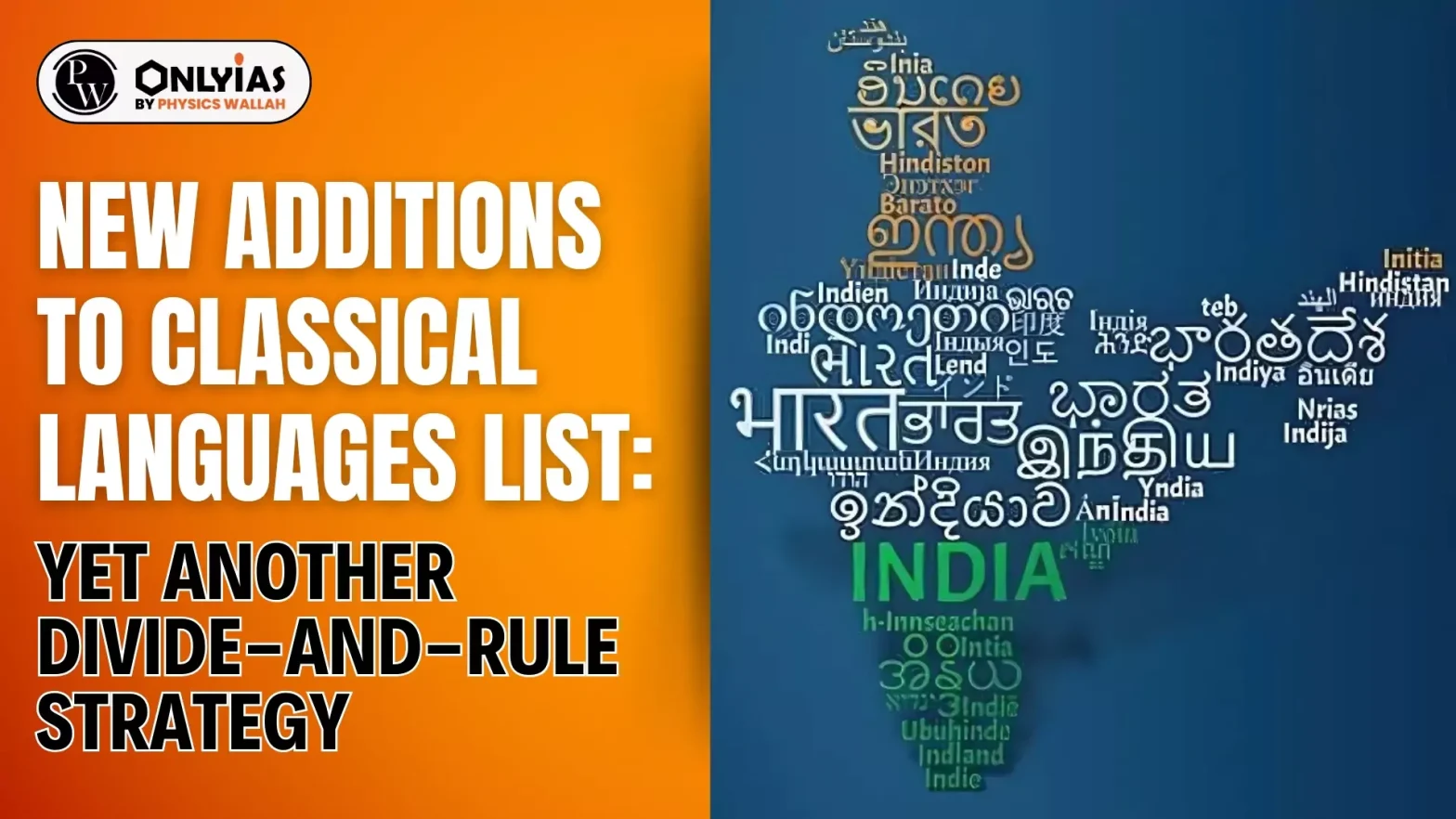The Union Cabinet has officially recognized five languages—Marathi, Pali, Prakrit, Assamese, and Bengali—as classical languages, raising the total to eleven. This decision has sparked debate among scholars regarding its implications for societal unity and the preservation of linguistic diversity.
Criteria for declaring a language as classical
- Historical Depth: The language must have early texts and recorded history that span 1,500–2,000 years.
- Rich Literary Heritage: It should have a collection of ancient texts or literature considered a valuable cultural legacy across generations.
- Original Knowledge Base: The language should have developed its own literary tradition, not borrowed from other linguistic communities.
- Unique Development: The classical form of the language, along with its literature, should be distinct from its modern versions (For e.g. Tamil is a modern version of the original Tamil language) with the possibility of a clear break in continuity between the classical language and its later forms or derivatives.
Enroll now for UPSC Online Course
Benefits of Recognizing Classical Languages
- Support for Study and Preservation: The government promotes the study, preservation, and revitalization of classical languages, safeguarding India’s intellectual and cultural heritage.
- Encouragement for Scholarly Research: Recognizing these languages stimulates academic research and the rediscovery of ancient texts and knowledge systems.
- Prestigious Awards: Two international awards—Presidential Award of Certificate of Honour and Maharshi Badrayan Samman—are given annually to scholars excelling in classical language research and promotion.
- Academic Focus: The University Grants Commission (UGC) funds the establishment of Professional Chairs in central universities and research institutions to advance classical language studies.
- Employment Opportunities: Recognition opens up job prospects in academia, research, archiving, translation, publishing, and digital media.
- Cultural Pride and Integration: It fosters pride and a sense of ownership among speakers, supporting national integration and promoting a self-reliant, culturally rich India.
Understanding the Concept of Classical
- Contrary to popular belief, “classical” status is not an inherent linguistic characteristic but a retrospective historical classification.
- Classical languages like Sanskrit, Tamil, and Greek are considered “root” languages, influencing the development of modern languages by providing words, affixes, and structures.
- For example, the Latin suffix “-er” in “computer” illustrates this impact.
- The term “classical” gained prominence during the European Enlightenment, as nations like France, Prussia, and England sought to revive the legacies of Latin and Greek to bolster their imperial ambitions.
- This classification, far from being neutral, has historically carried socio-political implications, often used to validate one language as “superior” while others are labelled “vernacular” or “barbaric.”
Prakrit Language
- The “Prakrit” language represents a diverse array of regional dialects, including Gandhari, Maharashtri, Shauraseni, and Kamrupi, with some classifications even considering Pali as a Prakrit.
- These languages are remnants of pre-Sanskrit linguistic traditions that flourished for millennia in the Indian subcontinent.
- The term Prakrit signifies an earlier linguistic phase that gave rise to several modern Indian languages, such as Gujarati, Bangla, Marathi, and Odia.
|
Check Out UPSC CSE Books From PW Store
Concerns Regarding the Inclusion of Prakrit as a Classical Language
The proposal to include Prakrit among classical languages raises several concerns:
- Questionable Classical Status: Its contributions remain fragmented and comparatively lesser-known than the more established giants of Sanskrit, Pali, and Tamil.
- Given its limited literary legacy and regional variations, the recognition of Prakrit as a classical language seems less compelling.
- Historical Context: Around 9,000 to 8,000 years ago, the Holocene migration to India established human settlements.
- Though there is no written evidence of pre-Sanskrit languages, they likely influenced Prakrit, which should be regarded as a collection of dialects rather than a single language.
Negative Implications of the Classical Language Status
- Political Ramifications: The designation of classical status often fostering a sense of majoritarian pride among their speakers.
- This can alienate speakers of less recognized languages, leading to social divisions akin to those created by caste and religion.
- Such perceptions reinforce the notion that some languages—and their speakers—are viewed as inherently more “civilized,” thereby undermining the principle of linguistic equality.
- Threat to Linguistic Diversity: As major languages dominate education and public discourse, smaller languages may decline, diminishing cultural diversity and the unique worldviews they represent.
The language hierarchy can be outlined as follows:
- Over 1,000 mother tongues: The base layer, representing the vast linguistic diversity.
- A little over 100 languages: The recognized languages that are spoken more broadly.
- 22 scheduled languages: Officially recognized languages in the Constitution of India.
- 11 classical languages: The highest status, representing languages of ancient origin and significant cultural influence.
|
Enroll now for UPSC Online Classes
Conclusion
Every language represents a unique worldview and deserves respect. If only a select few receive recognition, India risks becoming a republic of languages, as in George Orwell’s Animal Farm, where some are favoured over others, undermining true equality and unity.
![]() 7 Oct 2024
7 Oct 2024

